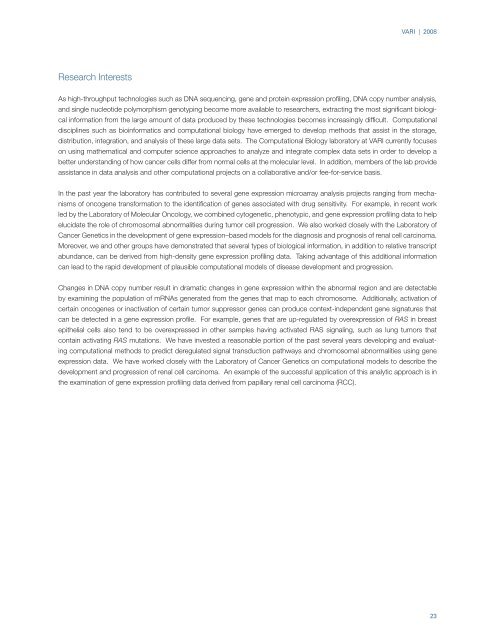2008 Scientific Report
Create successful ePaper yourself
Turn your PDF publications into a flip-book with our unique Google optimized e-Paper software.
VARI | <strong>2008</strong><br />
Research Interests<br />
As high-throughput technologies such as DNA sequencing, gene and protein expression profiling, DNA copy number analysis,<br />
and single nucleotide polymorphism genotyping become more available to researchers, extracting the most significant biological<br />
information from the large amount of data produced by these technologies becomes increasingly difficult. Computational<br />
disciplines such as bioinformatics and computational biology have emerged to develop methods that assist in the storage,<br />
distribution, integration, and analysis of these large data sets. The Computational Biology laboratory at VARI currently focuses<br />
on using mathematical and computer science approaches to analyze and integrate complex data sets in order to develop a<br />
better understanding of how cancer cells differ from normal cells at the molecular level. In addition, members of the lab provide<br />
assistance in data analysis and other computational projects on a collaborative and/or fee-for-service basis.<br />
In the past year the laboratory has contributed to several gene expression microarray analysis projects ranging from mechanisms<br />
of oncogene transformation to the identification of genes associated with drug sensitivity. For example, in recent work<br />
led by the Laboratory of Molecular Oncology, we combined cytogenetic, phenotypic, and gene expression profiling data to help<br />
elucidate the role of chromosomal abnormalities during tumor cell progression. We also worked closely with the Laboratory of<br />
Cancer Genetics in the development of gene expression–based models for the diagnosis and prognosis of renal cell carcinoma.<br />
Moreover, we and other groups have demonstrated that several types of biological information, in addition to relative transcript<br />
abundance, can be derived from high-density gene expression profiling data. Taking advantage of this additional information<br />
can lead to the rapid development of plausible computational models of disease development and progression.<br />
Changes in DNA copy number result in dramatic changes in gene expression within the abnormal region and are detectable<br />
by examining the population of mRNAs generated from the genes that map to each chromosome. Additionally, activation of<br />
certain oncogenes or inactivation of certain tumor suppressor genes can produce context-independent gene signatures that<br />
can be detected in a gene expression profile. For example, genes that are up-regulated by overexpression of RAS in breast<br />
epithelial cells also tend to be overexpressed in other samples having activated RAS signaling, such as lung tumors that<br />
contain activating RAS mutations. We have invested a reasonable portion of the past several years developing and evaluating<br />
computational methods to predict deregulated signal transduction pathways and chromosomal abnormalities using gene<br />
expression data. We have worked closely with the Laboratory of Cancer Genetics on computational models to describe the<br />
development and progression of renal cell carcinoma. An example of the successful application of this analytic approach is in<br />
the examination of gene expression profiling data derived from papillary renal cell carcinoma (RCC).<br />
23

















